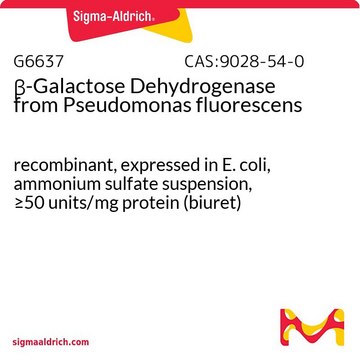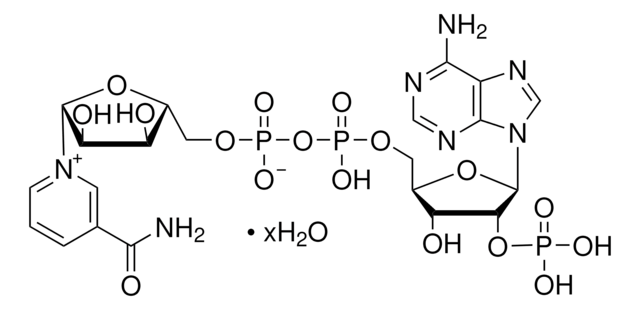N1636
β-Nicotinamide adenine dinucleotide hydrate
purified by column chromatography, ≥99%
Synonym(s):
β-DPN, β-NAD, Coenzyme 1, Cozymase, DPN, Diphosphopyridine nucleotide, NAD, Nadide
About This Item
Recommended Products
Quality Level
Assay
≥99%
form
crystalline powder
color
white
storage temp.
−20°C
SMILES string
NC1=NC=NC2=C1N=CN2.O[C@@H]3[C@@H](COP(O)(OP(OC[C@@H](O4)[C@@H](O)[C@@H](O)[C@H]4[N+]5=CC=CC(C(N)=O)=C5)([O-])=O)=O)OC[C@@H]3O
InChI
1S/C21H27N7O14P2/c22-17-12-19(25-7-24-17)28(8-26-12)21-16(32)14(30)11(41-21)6-39-44(36,37)42-43(34,35)38-5-10-13(29)15(31)20(40-10)27-3-1-2-9(4-27)18(23)33/h1-4,7-8,10-11,13-16,20-21,29-32H,5-6H2,(H5-,22,23,24,25,33,34,35,36,37)/t10-,11-,13-,14-,15-,16-,20-,21-/m1/s1
InChI key
BAWFJGJZGIEFAR-NNYOXOHSSA-N
Looking for similar products? Visit Product Comparison Guide
Related Categories
General description
Application
- to measure adenosine triphosphate (ATP) synthesis rates (kinetics measurements)
- in the reaction buffer for pyruvate kinase (PK) activity assay
- as a component of master mix for a high throughput screening
Biochem/physiol Actions
Packaging
Other Notes
Storage Class Code
13 - Non Combustible Solids
WGK
WGK 3
Flash Point(F)
Not applicable
Flash Point(C)
Not applicable
Personal Protective Equipment
Regulatory Listings
Regulatory Listings are mainly provided for chemical products. Only limited information can be provided here for non-chemical products. No entry means none of the components are listed. It is the user’s obligation to ensure the safe and legal use of the product.
JAN Code
N1636-100MG:
N1636-250MG:
N1636-VAR:
N1636-1G:
N1636-25MG:
N1636-BULK:
Choose from one of the most recent versions:
Already Own This Product?
Find documentation for the products that you have recently purchased in the Document Library.
Customers Also Viewed
Articles
Learn about the four membrane-bound protein complexes that make up the electron transport chain metabolic pathway supplying energy as ATP for cellular respiration.
Our team of scientists has experience in all areas of research including Life Science, Material Science, Chemical Synthesis, Chromatography, Analytical and many others.
Contact Technical Service





